This document covers the following topics:
This section describes how the Adabas Bridge for DL/I (ADL) handles DL/Icheckpoint calls and, in the case of an abnormal end to a program, how the database can be recovered and the application program restarted.
Note that the recovery and restart logic and procedures for Natural applications or programs using direct Adabas calls are not affected by ADL.
In DL/I, an application program may set checkpoints using the
CHKP call. This results in the confirmation of all changes to the
database made by the program up to this point. In addition, under z/OS, the
XRST routine allows the use of "symbolic
checkpointing", with which user data may be saved for each checkpoint.
These data can later be used to restart the program, should it have terminated
abnormally.
The ADL reproduces the full functionality of the DL/I XRST
and CHKP calls and thus provides complete restart and recovery
capabilities.
Adabas provides two basic methods of checkpointing:
ET ("end of transaction") logic, intended to be used for updating files concurrently, and
C1 checkpoint calls, intended to be used by programs which use files exclusively.
Both the ET and C1 checkpoint methods are used
by ADL.
Symbolic checkpointing is also possible under z/VSE, thus allowing full recovery/restart capabilities.
The following restrictions apply to ADL:
The use of time stamps instead of checkpoint identifiers is not supported.
OS/VS checkpoint requests are not supported.
(for IMS/TP BMP only) "LAST" may not be used to indicate
that the program is to be restarted from the last issued checkpoint. Instead,
establish the checkpoint identifier of the last issued checkpoint using the
messages on the DAZOUT1 file, and then supply this for the
XRST call.
As mentioned above, the restart/recovery logic used by Adabas in a given situation mainly depends on how an application program accesses the data base. Three user types are distinguished: access-only users (ACC), exclusive file users (EXU) and ET logic users (UPD). ADL uses all of these: which type will be used in a given situation depends on the following features:
the operational environment;
the mode in which the application program is run (the first three characters in the parameter statement);
how the files in the data base are accessed (read only, update), as determined by the PSB specified for the program; and
the method of (DL/I) checkpointing used (without checkpointing, basic checkpointing or symbolic checkpointing).
The following tables show how ADL applies the Adabas user types and checkpoint methods, e.g. the last column in the first table means
1st table: "STA" is specified for DAZIFP, i.e. the program runs as "stand-alone".
Last block "Update": The program makes updates.
Last column in block "Symb": The program uses symbolic checkpointing.
Under these conditions, ADL runs the program as Adabas "EXU" user (indicated in the third line), it issues no ETs (forth line) but uses "C1" commands (fifth line) for the ADL checkpoint method.
Two situations may be distinguished:
where "STA" has been specified as the first positional parameter for DAZIFP
where "DLI", or "IMS" has been specified as the first parameter for DAZIFP
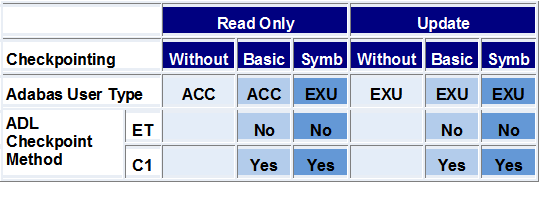
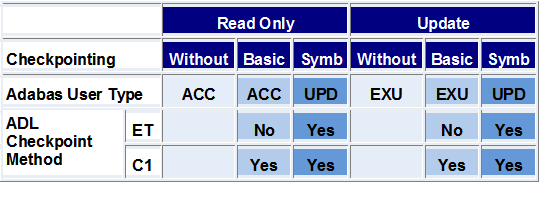
The advantage of using the "STA" parameter for
normal batch programs is that no ET calls have to be issued.
However, other application programs also using symbolic checkpoints cannot run
concurrently. This is because STA programs use the ADL directory
file as exclusive (EXU) users.
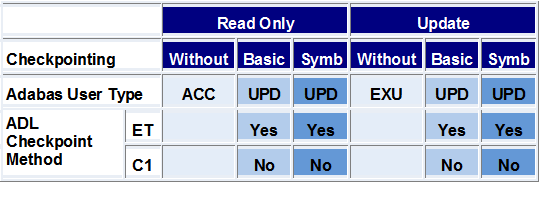
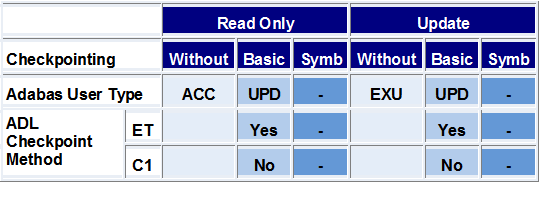
Adabas ET logic allows concurrent processing of one or more
files by more than one user. All records which are updated by a program are
held in a queue and may not be updated by any other user until the program
issues an Adabas ET call. This results in a confirmation of all
updates made by the program and the release of the held records. However, the
use of ET logic for programs (e.g. batch programs) which use files
as exclusive users or which do not update these files is not recommended.
If ET calls are not issued often enough, the Adabas hold
queue for update records may overflow, resulting in a fatal error. On the other
hand, ET calls should not be issued too frequently, in order to
avoid unnecessary buffer flushes.
ADL includes an option to issue ET calls automatically. The
actual procedure performed depends on the program type and the operational
environment. Automatic ETs will be issued in the following cases:
Normal Batch and SDB, BMP (z/OS) or MPS (z/VSE) Programs
ADL issues ET calls automatically. The
ET parameter provided when creating the ADL parameter
module (see the section ADL Parameter
Module in the ADL Installation
documentation ) or as a keyword for DAZIFP, determines the number
of changes which can be made to the root segment position in the database
(summarized over all PCBs in the PSB) before an ET call is
automatically issued. For some batch programs it may be desirable not to issue
ET calls at all. This can be achieved by specifying
"ET=NO".
IMS/TP
ADL automatically issues an ET call each time the
application program issues a GU call on the I/O PCB.
CICS Environment
Under CICS, all users are ET logic users and ADL will
automatically issue an ET call in two situations:
where the application program issues an explicit termination call, and
every time an implicit termination call is taken (i.e. at the end of a task).
When a program terminates abnormally, an Adabas BT call
is issued and all database modifications made by this program are backed
out.
If OPENRQ=YES has been specified when assembling the
parameter module DAZPARM, ADL will issue an Adabas "OP" each time
a scheduling call is received, and a "CL" for the termination
call.
The figures on the following pages explain how ADL uses restart/recovery logic for different program types and operational environments.
Two situations may be distinguished:
with "STA" as the first positional parameter specified
for DAZIFP
with "DLI" or "IMS" specified as the first
parameter for DAZIFP
These two cases are described in the tables below.
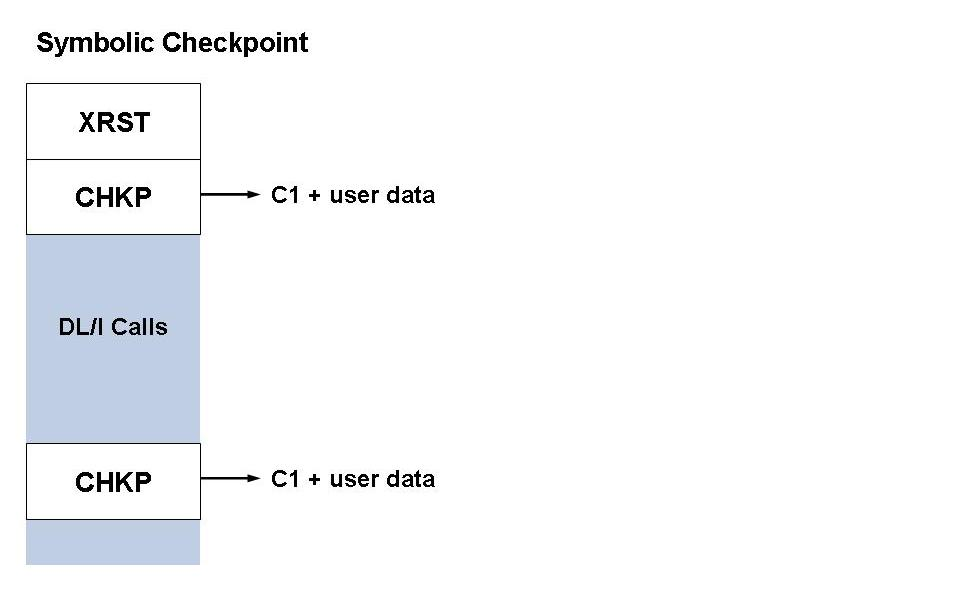
In the case of basic checkpointing, it is recommended that DLI or IMS
be used instead of STA as the first parameter for
DAZIFP to avoid the ADL directory file being in exclusive
mode.
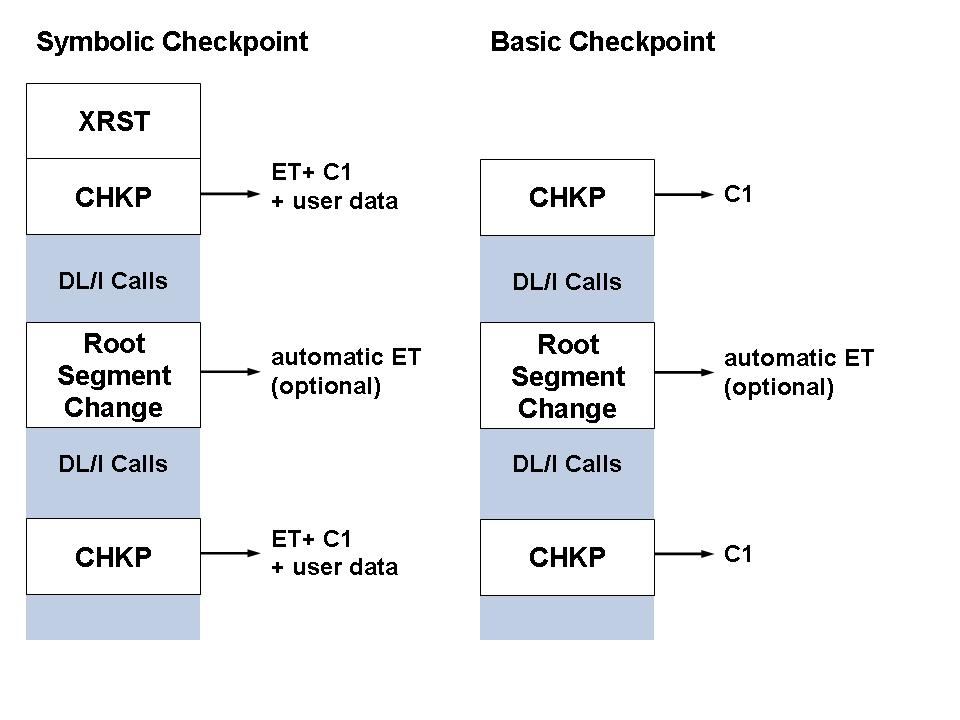
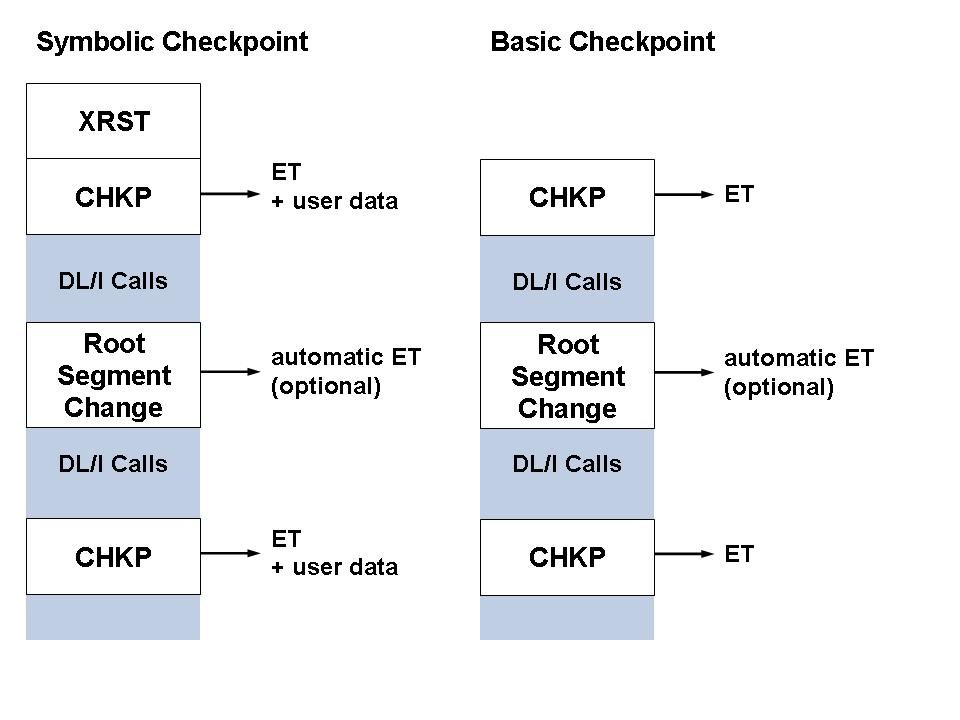
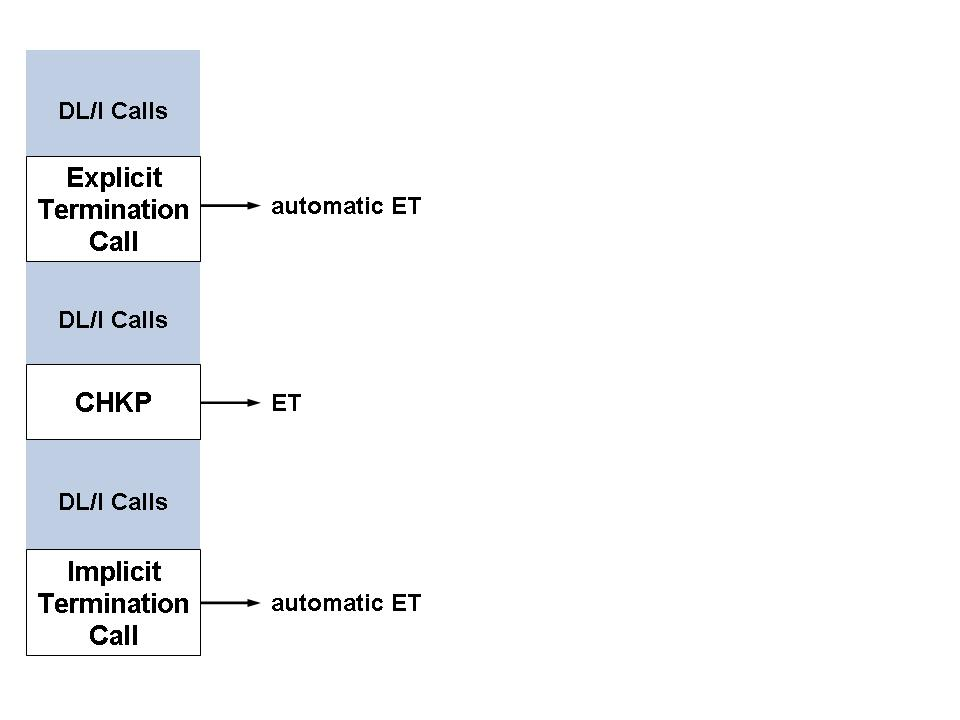
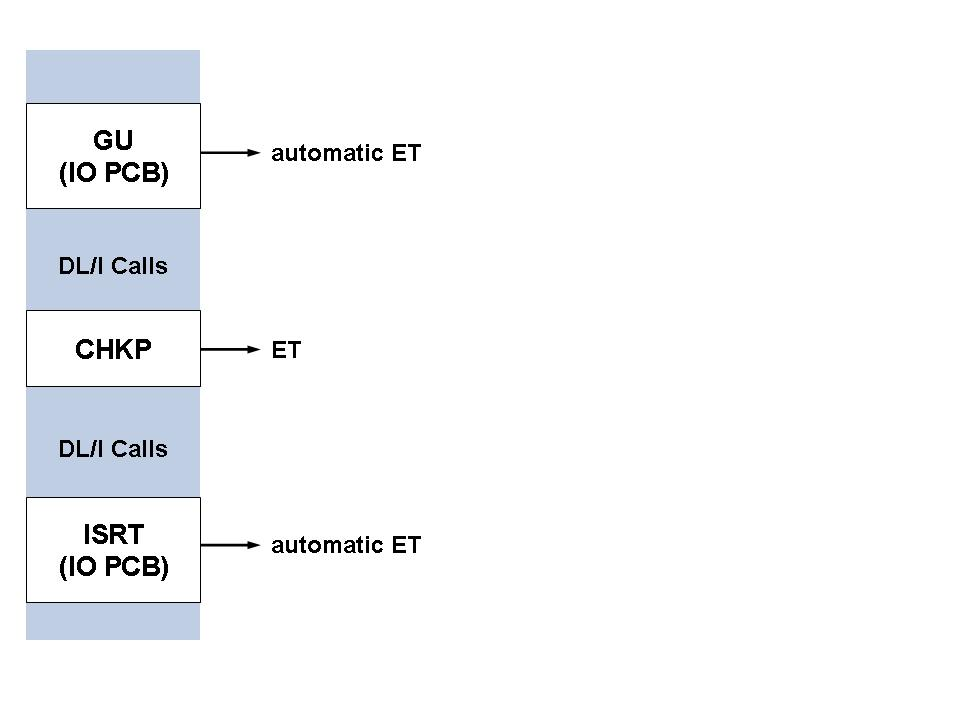
With a CHKP call, the following message is written to the
DAZOUT1 file:
'DAZCHKP - CHECKPOINT WRITTEN. DATE: dd/mm/yy TIME: hh/mm/ss FOR PROGRAM progname WITH CHECKPOINT-IDENTIFIER chkpiden'
where
| dd/mm/yy | is the actual date, |
| hh/mm/ss | the actual time, |
| progname | the name of the application program, |
| chkpiden | the eight-character checkpoint identifier as passed to the CHKP call. |
If the symbolic checkpoint call is used, up to seven data areas are stored on the ADL directory file. The checkpoints on the latter are identified by the name of the program and the eight-character checkpoint identifier.
Finally, ADL issues an ET and/or a C1 call.
In the Adabas checkpoint table, the checkpoints associated with the
C1 call are identified by the checkpoint name "CHKP".
Please refer to the Adabas Utilities documentation for
details on how to obtain and read the Adabas checkpoint table.
If a program ends normally, the corresponding checkpoint entries on the ADL directory file will be deleted. If a program ends abnormally, these entries will be deleted after the program has been restarted. An abnormally ended program which is never restarted will thus produce garbage in the directory file. In order to clear the ADL directory file, run a dummy program containing only an XRST call. This dummy program must have the same name as the abnormally terminated program.
Alternatively, you can list and delete the checkpoint entries in the ADL directory with the ADL Online Services as described in the section The ADL Online Services in this documentation.
ADL issues an ET call for each CHKP call.
In all cases, the current position in the data base will be deleted
after a CHKP call. In the case of a restart, the position is
NOT reestablished after an XRST call.
To restart a batch program, perform the following five steps:
Use the output of the application program on the DAZOUT1
file to find the checkpoint identifier and the date and time of the checkpoint
at which you want to restart your program.
Find the corresponding protection log number and block number of the
desired checkpoint in the Adabas checkpoint table. This table may be obtained
using the Adabas ADAREP (report) utility. See the Adabas
Utilities documentation for more details.
Make a copy of the protection log file using the Adabas
ADARES (restart) utility with either the COPY or the
PLCOPY function, for single or dual protection logging
respectively. The following ADARUN and ADARES
statements are provided as an example (dual protection logging was active):
ADARUN input statement:
ADARUN PROGRAM=ADARES,MODE=SINGLE
ADARES input statement:
ADARES PLCOPY DUALPLD=3350
See the Adabas Utilities documentation for more details.
Restore the entire data base or one or more of its files to the state in
effect when the desired checkpoint was taken, using the Adabas
ADARES utility with the BACKOUT function. The
following ADARUN/ADARES input statements are provided as an
example.
ADARUN input statement:
ADARUN PROGRAM=ADARES,MODE=SINGLE
ADARES input statement:
ADARES BACKOUT FILE=37,PLOGNUM=8,TOCP=CHKP,TOBLK=19
File 37 is restored to the checkpoint which is found on protection log file 8 in block 19 (all checkpoints issued by ADL are named CHKP). Please refer to the Adabas Utilities documentation and the Adabas Operations documentation for more details.
Restart your program. The eight-character checkpoint identifier may be
supplied either with the CPID keyword for DAZIFP or
in the I/O area referenced by the XRST call in the application
program. If both methods are used at the same time, the value provided with the
CPID keyword will be used.
If the checkpoint is not found on the ADL directory file, or if the
XRST call requests more data than have been previously stored with
the CHKP call, ADL will issue an error message and abend the
application program immediately.